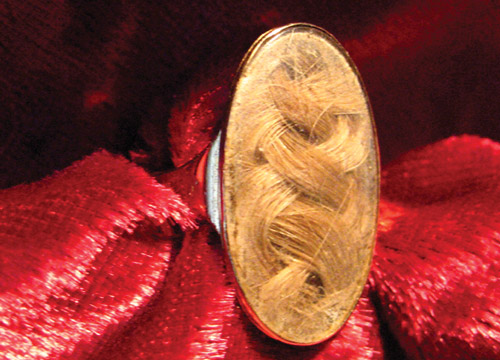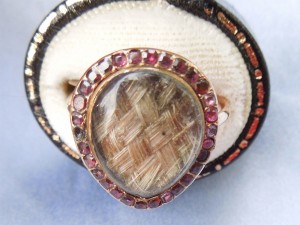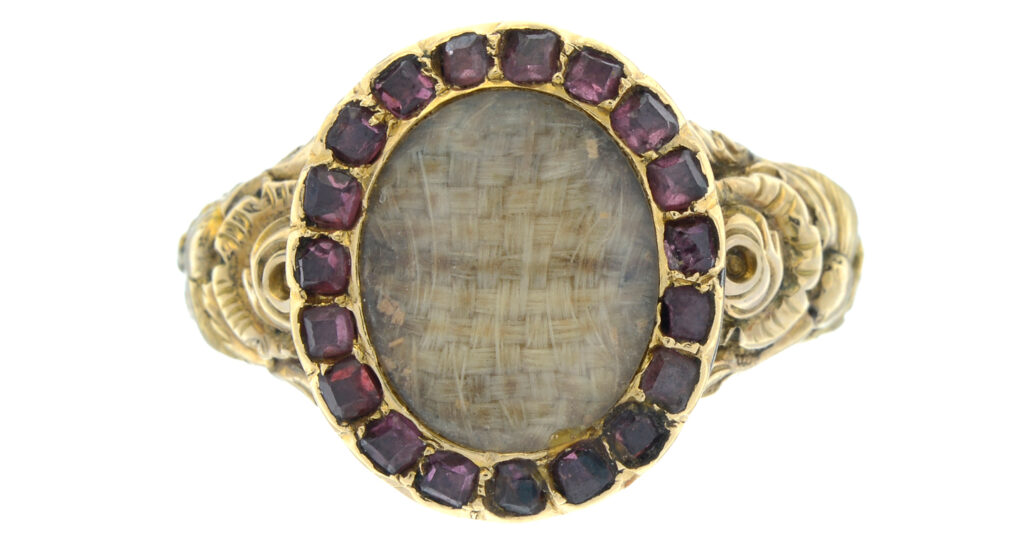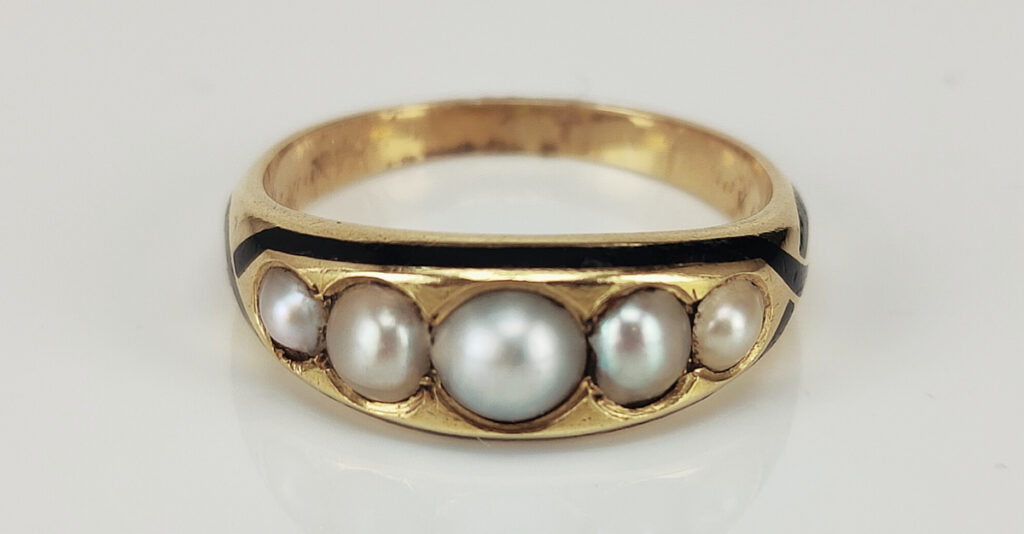English/Hebrew Dedicated Mourning Ring, 1780
The fundamental principal of a mourning jewel is to secure the memory of a person and ensure that this memory lasts forever. To justify this, the memorial is, in itself, a monument to the spirt’s passage into the afterlife and the longevity of that spirit through the memory of others. Regardless of religion or faith, the need to cling to this hope of the afterlife relates to the jewel, even at times when the very elements of a religion have been heavily questioned. In this ring, we have the perfect harmony of religious piety, personal fidelity and memorial style in a time when the very nature of ecclesiastical domination in England was challenged through art in the Neoclassical period.
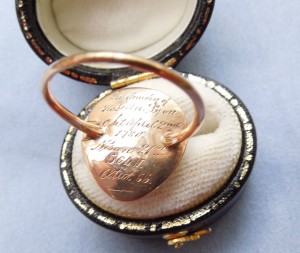
Inscriptions
Within this ring, we have the dual inscriptions of:
“In memory of Rosetta Lyon, obit April 2, 1780, Nisan 21, 5640, AtAT 66″
Two elements are important to note here; one is the combination of the Hebrew/Christian calendar and the other is the age of 66. Being 66 shows a healthy existence for the 1780s, a time of high mortality during the burgeoning Industrial Revolution; something which shows a control of wealth within a household. Combined with the garnets and the fine weave of the hair, this ring was not one produced for a simple token of love. There is the heart element, a popular one in the 18th century, showing design in its creation. With the Hebrew calendar of Nissan, coinciding with March-April (here, April 2nd), we see the influence of the Jewish dedication, which makes this ring relevant to a Jewish person of significant status in society. Jewels of this period could accommodate different inscriptions, based on generic designs. Hairwork is often one of the first elements to consider when viewing a piece for its quality, as hair weaving takes significant investment and the garnets are important to factor in as being of wealth. For the 1780s, simple oval rings with twists of hair, rather than woven, under crystal or glass (usually glass) were the most typical.
In the above ring, we can see the simplicity of the ring, which would have the basic inscription to the reverse.
Religion in the Late 18th Century
The development of the Jewish population in England to the 18th century had been difficult. Jewish persecution from the exclusion of guilds (effectively preventing men from working a trade) to general resentment for their seeming privileges and the accusation of a Jewish murder of a Christian child in Norwich incited anti-Jewish violence. There was a spate of Jewish attacks of the 12th century, led on by the Crusades and even further into the 13th century. Even in 1222, Deacon Robert of Reading was burned for converting to Judaism, more can be read about this in:
The anti-Semitic feeling was heightened by Henry III who taxed the Jewish population heavily. This led to heavy emigration, which was followed by Edward I, who had sized their possessions and expelled the Jewish population in 1290. Oliver Cromwell, who had effectively begun the rise of the mourning industry from his beheading of Charles I, allowed for Portuguese Jewish merchants to open a Synagog in Creechurch Lane, Aldgate in 1657. This allowance, the first since 1290, was a reflection of the times of England during the Cromwell era. Cromwell was politically utilising the influence of the Jewish community, as he had seen the benefit of the Jewish population to Holland, which was commercially rivalling England. His long-term goal was to expedite the Second Coming of Jesus Christ by having the Jews convert to Christianity, as in December 1655, quoted St. Paul’s Epistle to the Romans 10:12-15:
12 For there is no distinction between Jew and Greek, for the same Lord over all is rich to all who call upon Him. 13 For “whoever calls on the name of the Lord shall be saved.”
Israel Rejects the Gospel 14
How then shall they call on Him in whom they have not believed? And how shall they believe in Him of whom they have not heard? And how shall they hear without a preacher? 15 And how shall they preach unless they are sent? As it is written: “How beautiful are the feet of those who preach the gospel of peace Who bring glad tidings of good things!”
Even after the Restoration period of Charles II, the Jewish population was flourishing, with an estimated 1500 Jews, having immigrated from Europe. By the 18th century, the Jewish community was made up of jewellers, street traders/peddlers, textile/stationery/old goods merchants, tobacco workers, food sellers and brokers on the Royal Exchange. There is a permeation of society that had rapidly crossed through English culture, something which was facilitated by the place and time. With the Enlightenment changing social perceptions, there was more of an allowance for the Jewish population to thrive within culture, as culture was changing shape itself.
In 1753, the Jewish Naturalisation Act was received by royal assent on July 7th, but was repealed in 1754. Jewish support for the government during the Jacobite rising, which wished to instate Charles Edward Stuart to regain the Scottish throne for the exiled House of Stuart, was still not enough to ensure their security. This uprising was to create a Scottish monarchy at a time when the British Army was predominantly concerned with the War of the Austrian Succession in Europe. Sampson Gideon gave solidarity to the stock market and others had offered to defend London, which may have led to Henry Pelham’s introduction of the Jew Bill of 1753, but after passing the House of Lords, the House of Commons did not share such a view. Tories considered the bill an “abandonment of Christianity”, yet the Whigs, who were religiously tolerant, passed the bill.
Constant oppression over faith was still the dominant thought in 18th century England, with an enlightened society still never completely embracing equality through religion.
Culture and Community in the Late 18th Century
The 18th century’s new focus upon the aesthetic to represent the personal led into the Neoclassical era (c.1765) and was helped through by the Enlightenment and its challenges to traditional interpretations of personal/ecclesiastical relationships. From a socio-economic perspective, the Western world was being opened up through the Americas, spurred by new technologies and industry which could increase communications and travel. Levels of society that were static in their geographic region and anchored to their family/village had access to education in rising industries and create personal finance.
With the rise of the Industrial Revolution, increased manufacture of textiles, steam power and iron making led to the need for a society that could sell these products, creating work for peddlers in towns with growing populations, creating points of sale to growing societies which had previously been smaller and more insular. With heavy investment in inventions from the early 18th century, the growth of mechanised production was rapid. Inventions, such as the John Kay’s flying shuttle (patented in 1733) doubled the output of a weaver, were financed and patented to protect their intellectual property, creating extremely high return on investment for entrepreneurs, such as Richard Arkwright and developing industrial towns, the likes of which had not been seen in modern society. Indeed, Arkwright had amassed £500,000 by his death in 1792. Considering that a very fine silk dress in the early 18th century costed £10 to £60, this amassed wealth is incredible.
Neoclassicism had become the reaction of culture towards the dominant styles of Baroque and Rocco in art and architecture through England and France, which was mainly a reaction of religious questioning. The Baroque style was dominant in its grandeur; enforcing the rule of God upon a society who could not achieve the wealth to acquire such opulent architecture that would be found in a Church or aristocratic setting, hence the presence of God within art was a constant reminder of mortality. The Age of Enlightenment allowed for liberalism in thought and the right of the individual. John Locke and Thomas Hobbs were greatly influential in 17th century English progressive thought, whose resonance would be felt throughout the 18th century. In jewellery, the Neoclassical period led to the change from the actual depiction of mortality through the Memento Mori style (skulls, skeletons, scythes, tempus fugit) were replaced with allegorical depictions from classical art. The weeping female figure next to a tomb or plinth, dressed in classical costume were more typical to find by the 1790s, when the English Enlightenment had reached its height.
What this shows is the swing against the traditional domination of a singular religious thought, to the more literal appreciation of interpersonal relationships. For rings such as this one, it is a shift towards uniformity across cultures that would previously have been separated cultures. Combined with the growing levels of wealth through industry over aristocratic birth and there is the need for a new interpretation of mourning in a single culture.
The French adoption of mourning and sentimental symbolism differed from the necessity of the British. While Court mandates enforced multiple levels of society to enter mourning stages and present the family within a mourning paradigm, the French specifically targeted the art and culture of mourning in a more focused manner from the late 18th to late 19th century, often stemming from form following fashion. As mourning styles and materials became popular (such as hairwork), it was more entitled to enter French style. Much of this is due to religion, approach to culture and how it was mandated throughout the country. The 1789 Declaration of the Rights of Man and of the Citizen offered a freedom of religion, hence no control through Roman Catholicism, or in the case of the United Kingdom, the Church of England with the monarch as its Supreme Governor. This gives greater interpretation of mourning symbolism that can relate more specifically to the wearer and not be dominated by a preordained set of values.
The 18th century welcomed in greater convention for mourning fashion and began to see the rise of the mourning industry. This became so much so that mourning dress was becoming desirable and the difference between mourning and non mourning dress was narrowing. Much of the fashion in this century was dictated by the fabric rather than the cut, and the silk industries in France and England held major influence on mourning wear because of this. It was Ordre Chronologique des Deuils de la Cour, (1765) where details of Court mourning in France were published, giving precise tailoring instructions. From their first days in mourning, men were permitted to appear in Court, unless it was after the death of a parent from whom they had received inheritance.
Widows had to wait one year and six weeks, with the first six months in black wool. Lord Chamberlain and Earl Marshall both ordered shorter periods of mourning in France and England respectively. By the 1880s in Britain, twelve weeks of mourning were ordered by the death of a king or queen, six weeks after the death of a son or daughter of the sovereign, three weeks for the monarch’s brother or sister, two weeks for royal nephews, uncles, nieces or aunts and ten days for the first cousins of the royal family. Foreign sovereigns were mourned for three weeks and their relatives for a shorter time. Mourning was divided up into First, Second and Court mourning.
Though there had been growing small scale social mobility from the late 17th century, the late 18th and early 19th centuries saw the middle classes having the opportunity to promote through society with the accumulation of wealth. Augustus Welby Northmore Pugin, a designer, architect and convert to Catholicism, saw this Industrial Revolution as a corruption of the ideal medieval society. Through this, he used Gothic architecture as a way to combat classicism and the industrialisation of society, with Gothic architecture reflecting proper Christian values. Ideologically, Neoclassicism was adopted by liberalism; this reflecting the self, the pursuit of knowledge and the freedom of the monotheistic ecclesiastical system that had controlled Western society throughout the medieval period. Consider that Neoclassicism influenced thought during the same period as the American and French revolutions and it isn’t hard to see the parallels.
Garnets
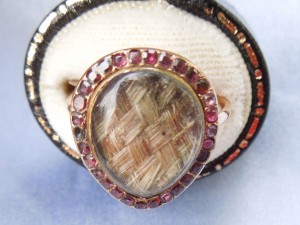
This ring shows a full surrounding of garnets around the hair dedication. Garnets, while not rubies, still have their sentimental representation in jewels and were a nice ancillary detail that did not need to be there.
There are primarily four types of garnet used in jewellery, varying wildly in colour (red to green). The ‘almandine garnets’ are the deep red/violet garnet, popular in late 18th and early 19th century jewels. In the 19th century, cutting the almandine en cabochon would make it become a carbuncle.
Demantoid garnets were found in Russia’s Ural Mountains post 1850, hence their lack of use before this date in earlier jewels. Their colour is bright green, closer to that of an emerald. Hessonite garnets are bright orange in colour, with their main supply stemming from Sri Lanka.
It is the ‘pyrotype garnet’ that is better known as the Bohemian garnet, due to their source being southern Europe, are deep red and mostly popular in Victorian jewels.
In this ring, we can see that there is variation in the garnets, as they are set within the ring. Notice the bezel and its curvature, an element popular in the 1780s.
The Heart
The Georgian Heart is a motif used in jewellery which actually predates the Georgian rule, was popularised by it. In this ring, we see the combination of the heart and the oval, which was a much more wide-spread shape in rings for the 1780s. The oval shape led to a change in how mourning jewels were presented with their sentiments and dedications, showing greater area for hairwork under glass in the bezel. This heart, if it could be considered such, does not have the northern point to denote it as a heart, but the southern area where it tapers down gives it an element of a heart shape.
As written about extensively at Art of Mourning, the heart is one of the most important sentimental love symbols in early-modern history. Its obvious symbolism resonates today in tokens of love and affection, moving beyond religious and social values to be the most purely recognised understanding of love. With an anthropomorphic design, the heart symbol became popular in the 17th century with its romantic undertones of giving ‘your’ heart to another. For more on the development of this symbol, please consult “Embellished Georgian Heart Love Pendant” and the following articles:
> Georgian Heart with Hairwork Twist in Crystal, 1824
> Three-Dimensional Urn Locket, Garnets, Pearls and Ribbon!
> Georgian Eye Miniature Inside a Pendant, c.1820
> Late Georgian Heart Pendant With Hairwork
> Rien Sans Amitie, Cabochon Garnet French Mourning Locket
> Merit Claims Esteem/Bow Heart Locket, 18th Century
> French Ribbon Pendant, 18th Century
> 18th Century Ribbon Motif Pendant
> An Eternity Knot in a Crystal Heart Pendant
> Mourning Crystal “Georgian” Heart
> Stuart Crystal Heart Pendant with Angels and Crown
> Memento Mori Stuart Crystal Heart
> Diamond Navette Ring, Late 18th Century
> 18th Century Diamond Fede Ring
> Late Georgian Heart Pearl Pendant 19th Century
> The Hon Alice Nugent in a 1730 Mourning Locket and the Hairwork Eternity
> Is It, Or Isn’t It? Heart Pendant – First Impressions
Shape of the Band and Bezel
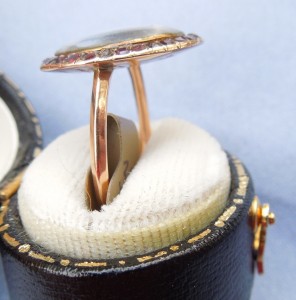
The band and bezel are the most essential consideration for a collector or historian. With this convex shape to the reverse of the bezel, jewels from the 1765-1780 period can easily be identified, without the concave shape of the navette rings of the 1790s. This shape is a very important one, as it shows development from the high-relief bezels of the Rococo period, that had the rosette-shaped reverse:
This reverse made way for the cleaner, convex shape of the 1763:
And that is the style which led to this ring. For collectors; be especially careful when you identify the jewel, many were often brooches that had been reappropriated as rings in later times. While the sentiment is there, it’s often good to check for solder marks or any infractions to the inscription upon the reverse, as these should be working in tandem with the band.
The band in this ring has the sharper edge to its outer-circle. This band was another identifier for its time, as wider bands were being used to accommodate the larger Neoclassical depictions in the bezel. Right on the balance of these particular styles, this ring shows the transition, as the heart shaped bezel is starting to take dominance over a ring that would be difficult to wear if it were any larger.
Hair
Woven hair is the element that brings the history of this ring, its place in society and its style together. Hair, being intrinsic to the wearer, was a personal statement of what love was felt between the union of two people. Here, we see the hair cross-woven in the ring. This does not reflect any particular cultural influence, apart from the fashion of the 18th century. A union of the self into the social fashion and the general feeling of love that related to the loss of a loved one created this ring.
Evolution of hairwork over the 18th century was rapid and on a large scale. Jewellery changed with fashion, as the two are intrinsically linked. Smaller styles of jewellery that had grown with the 17th century began to disappear and by around 1760, and new, larger forms became the standard. Hairwork over this time was becoming more affordable and a craft which ladies could do at home (though not to the extent of the 19th century). A letter from the Duchess of Portland to Miss Catherine Collingwood, written on December 1st 1735, suggests that ladies were in the habit of working the hair, leading the goldsmiths to provide the gold settings. Pieces made to order became more and more popular in the first half of the 18th century, with lockets (especially in the popular heart motif) containing hair becoming increasingly common. As larger jewellery with glass replaced faceted crystal, simple weaves of hair could be placed underneath, without it being a speciality craft or as expensive.
By the 1760s, hair was reintroduced in mass produced memorial medallions and lockets (in England and on the Continent), as it was mixed in with sepia and painted on to ivory. Sepia / hair painting is a typical and very popular method from the 1760s to around 1810, with many pieces being a standard style (sometimes chosen from a hairworker’s catalogue) and tailored to the individual with the appropriate name and inscription. Chopped hair also was a common feature of memorial art on ivory (sometimes vellum), with scenes / symbolism assembled with hair and glue. Hair weaving was also in high demand, with everything from brooches to miniatures holding a compartment in which to place the woven hair. Hair weaving was becoming far more intricate, with hair being entwined with pearls and gold.
The Statement
As a token of love, there is no greater sentiment than wanting to remember and reflect upon the life of a loved one than wearing it as a jewel. A piece of fashion that could transcend time and be worn publicly states the elements of the self as an emotion that has taken a physical form. This ring makes a fashionable statement in its presentation to society, but on the reverse, tells the personal tale of who wore it and why. The religious implications are still personal, being worn on the inside, but are still balanced by the Christian conventions of the society that it was constructed. What it does show is that love goes beyond these implementations and is something needing to be treasured, even as a memory.




